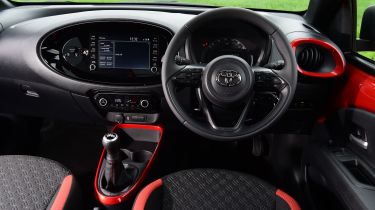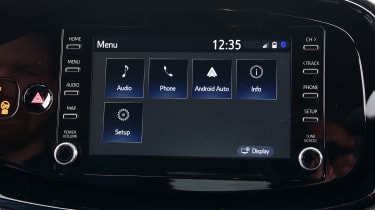Toyota Aygo X review - Interior, design and technology
The tiny Toyota’s new look has a sense of charm missing from the city car class in 2023
While the first two generations of the Toyota Aygo were relatively simple-looking city cars, the Aygo X has much more presence thanks to its funky, pseudo-SUV styling. It has a jacked-up ride height, blunt front end, cartoonishly large wheelarch trims, and 17 or 18-inch alloy wheels depending on spec – quite big for a car of this size. Throw in the two-tone paint finish and the option of an opening canvas roof, and there’s no denying Toyota has injected a new sense of fun to its dinky urban runabout.
The feeling continues inside, where you’ll find body-coloured flashes on the doors, around the gear lever and on the dash that contrast with the rest of the dark materials. It also helps to make the cabin feel cheerful if you go for a bolder paint colour like Chili Red and Juniper Blue. The old dash has also been tossed out, and replaced by a rounded, sweeping design that houses an integrated touchscreen and blends into the instrument panel.
Sat-nav, stereo and infotainment
The Aygo X either features a seven, eight or nine-inch central touchscreen depending on which trim level you go for. None of the set-ups feature built-in navigation, but you do get both Apple CarPlay and Android Auto as standard which makes up for it. Whichever smartphone system you use it fills the screen nicely, while the bright nine-inch display in the model we tested responds quickly to inputs.
The built-in infotainment system uses the same so-so interface that Toyota has used for some time. There aren’t many features – just access to media functions, trip info and not much else. The physical buttons on either side of the display make it simple to switch between menus, but the buttons themselves are small and fiddly to use. We do at least like that it uses white characters on a dark background so the large screen isn’t too distracting at night.
The climate controls sit in a separate panel below the main screen, and the simple knobs and switches are as intuitive as you’d hope. The instrument panel is also very simple; an LCD display, presenting trip and safety information, sits below a large speedometer and to the right of a much smaller rev counter.






